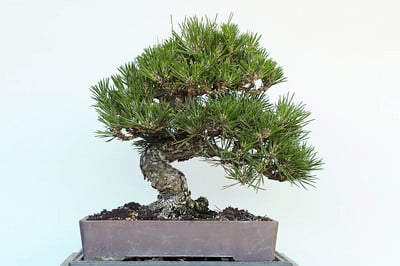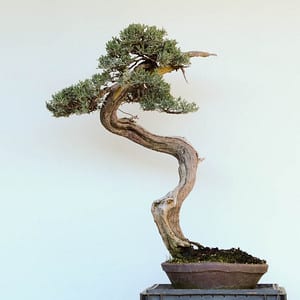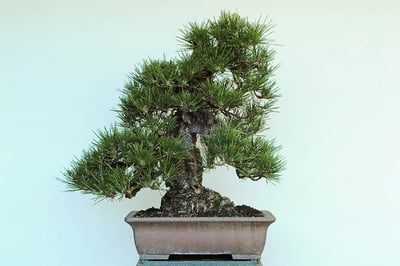Bay Island Bonsai’s 11th annual exhibit is scheduled for January 16-17, 2010. It will be held in a new location – the Alameda County Fairgrounds – in Pleasanton, CA. In preparation for the event, I began selecting trees to display in January. In July, I put together a few trial displays to get a sense of how I might display the trees I planned to exhibit. I realized, at the time, that I had a bit of work cut out before the exhibit.
Planning, it turns out, only gets you so far in bonsai. The final decisions about what will or won’t be shown depend, in large part, on how good the trees look at exhibit time. This is why many of the great shows, like Kokufu, are juried a matter of weeks before the actual event. For the most part we have a good idea of what trees will make it into our exhibit well ahead of time, but there are always surprises as the event draws near.
I’m now considering showing up to four trees this year: a maple, a juniper, and two pines. I can’t yet say which will make the cut. Beginning tomorrow, I’ll be working on each in an attempt to get them show ready. This will entail a bit of wiring, plucking, cutback and repotting.

Trident maple
I’ve shown the trident maple above on a couple of occasions, most recently in 2005, but the other three trees have yet to be shown. As deciduous trees aren’t typically shown with wire, preparing the maple will include the usual cutback, cleanup and repotting, but it won’t, thankfully, include wiring.
Pines, on the other hand, can show well with wire. How to know when to wire and when to pass? That’s a good question that can make for wonderful debate when the tree in question is ancient and shows loads of character. When the tree is young, like the the 15 year-old specimen below, it’s harder to get away with sloppy branch placement. I’ll start by pulling extraneous needles and then see what else is needed. With or without additional wire, the tree will benefit greatly from a more appropriate pot.

Japanese black pine
A fellow BIB member and I split a juniper several years ago and I ended up with the half pictured below. Another way of putting it: the owner of the other half of the tree realized that his half would be better off without the bit you see below. It’s been a fun project.

Western juniper
The corkbark pine below previously belonged to the late Mas Imazumi – a very prominent and much missed teacher who popularized bonsai around the U.S. for decades. I’ve been returning the tree to its former vigor over the past few years and was happy to see that it filled in well this summer. I don’t know if I can get it ready for show this time around, but I expect it won’t be too much longer if it doesn’t go in this year.

Japanese black pine – corkbark
For years, I’ve been particularly opinionated about which trees belong in BIB’s exhibit and which trees don’t. Despite Boon’s encouragements, a number of us have repeatedly turned down requests to show our trees for fear that they just aren’t ready. After years of maintaining a hard line on the topic, I’m beginning to soften a bit. Not about what makes for quality trees, but about which trees are ready for exhibit. In a “perfect” world, with benches overflowing with outstanding trees, yes, I’d be happy to uphold rigorous standards. But in our world, a world rife with opportunities to improve our trees, I’m warming to Boon’s mantra of, “Show it one way this year – we’ll improve it and show it another way next time.” At least, that’s what I’m telling myself about this year’s candidates.
Subscribe to Bonsai Tonight
New Posts Delivered Every Tuesday and Friday